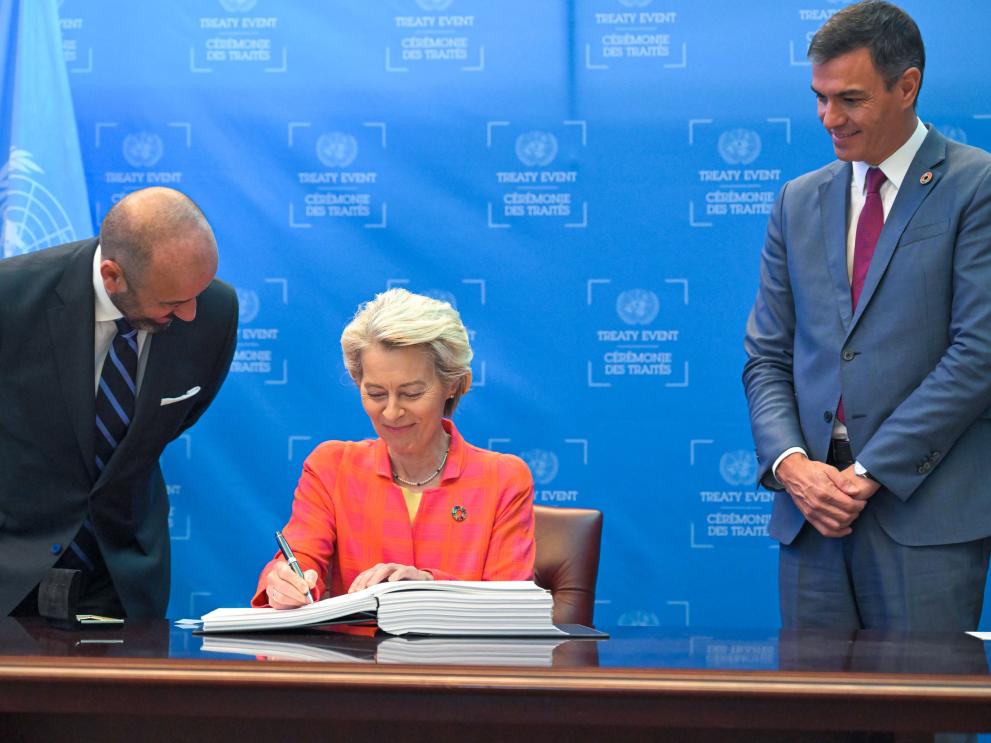The High Seas Treaty, also known as the agreement on Biodiversity Beyond National Jurisdiction or 'BBNJ', was signed in New York on 20 September, in the margins of the United Nations High Level Week.
In addition to the EU as organisation, many countries signed the treaty.
The agreement provides for the common governance of about half of the Earth’s surface and 95% of the ocean’s volume, the largest habitat on our blue planet, to:
- promote equity and fairness
- tackle environmental degradation
- fight climate change, and
- prevent biodiversity loss in the high seas
The adoption of this agreement is a historic achievement marking the successful end of more than a decade of multilateral work. It complementsthe United Nations Convention on the Law of the Sea (UNCLOS), which provides the legal framework under which all human activities in the ocean take place.
“President of the Commission Ursula von der Leyen and Spanish Prime Minister Pedro Sánchez have signed the High Seas Treaty on behalf of the EU, leading by example other countries to do the same. It is a historic day for the protection of the High Seas!” said Commissioner for Environment, Oceans and Fisheries Virginijus Sinkevičius. “But we need to keep working towards a swift ratification, with the hope that the treaty can enter into force by the June 2025 UN Ocean Conference in Nice, France.”
The text of the treaty was agreed in March 2023 and formally adopted on 19 June, by consensus, at UN Headquarters in New York. It will enter into force after 60 ratifications.
A key role for the EU
The EU and its Member States have played a key role in reaching the agreement, by leading a 'High Ambition Coalition' on BBNJ of 52 countries, committed at the highest political level.
The EU has also pledged to support the treaty’s implementation in particular by developing countries from the EU Global Ocean Programme.
It has invited members of the High Ambition Coalition on BBNJ to do the same within their capabilities.
Next steps
Once ratified, the High Seas Treaty will allow the establishment of marine protected areas in the high seas at global level, safeguarding the ocean from human pressures in a major contribution to reducing climate change, to protecting biodiversity and achieving the objective to protect at least 30% of the planet by 2030. The treaty thus addresses a blaring gap in ocean protection, as only about 1% of the high seas is currently protected.
The treaty also sets a framework for a fair and equitable sharing of monetary and non-monetary benefits from marine genetic resources, and for capacity building and transfer of marine technologies to developing countries, as well as a voluntary fund to support developing countries to achieve UN Sustainable Development Goal 14 on 'Life Below Water'.
Background
Areas beyond national jurisdiction comprise the high seas and the seabed beyond national jurisdiction.
They contain marine resources and biodiversity and provide invaluable ecological, economic, social, cultural, scientific and food security benefits to humanity. However, they are under mounting pressure from pollution, overexploitation, climate change and biodiversity loss. For better addressing these challenges, and in view of future increasing demands for marine resources (for food, medication, energy, for example), it appeared necessary to establish a new treaty.
This High Seas Treaty should also be instrumental for increasing coherence, coordination and synergies among the ocean-related activities carried out by many organisations and stakeholders, thus contributing to a more holistic management of activities in the high seas.


